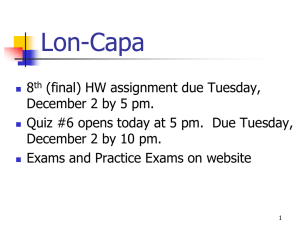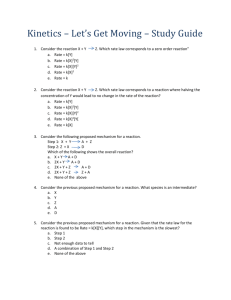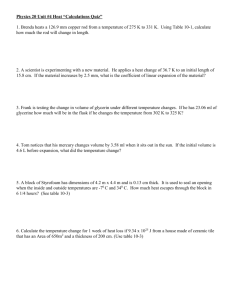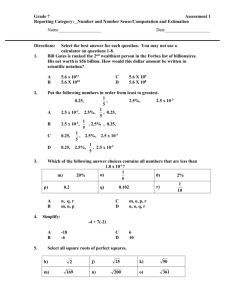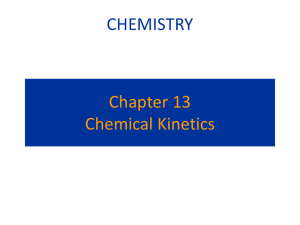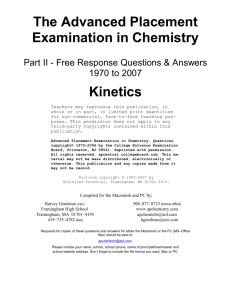AP KineticsFR Key (a) 1st order with respect to A, 1st order with
advertisement
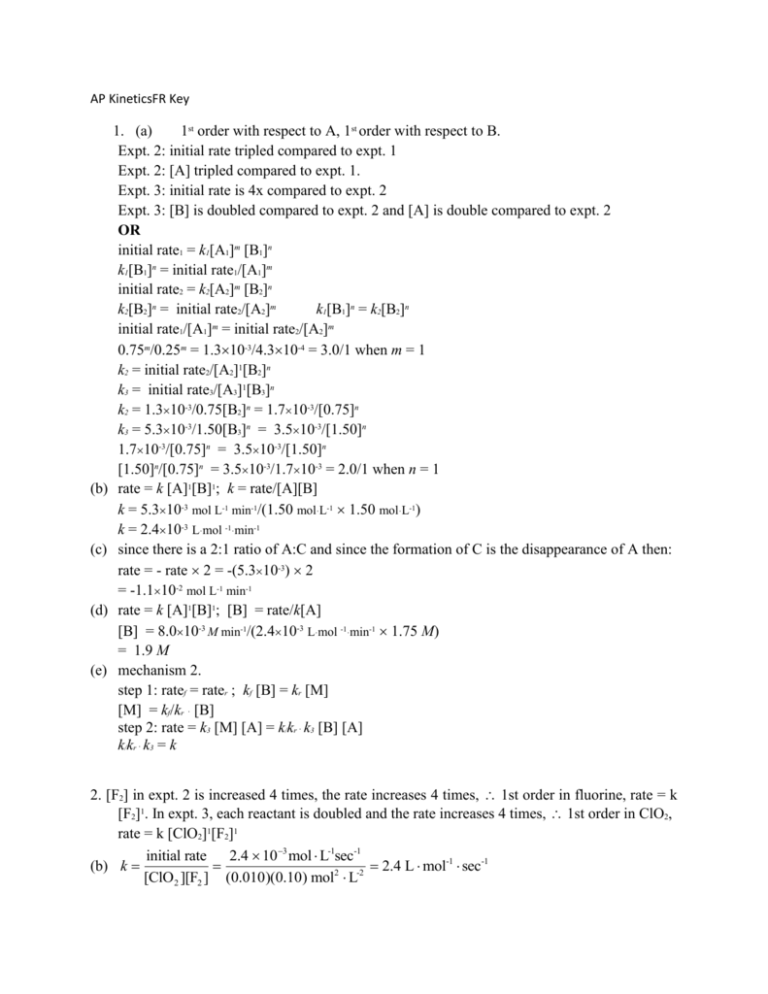
AP KineticsFR Key (b) (c) (d) (e) 1. (a) 1st order with respect to A, 1st order with respect to B. Expt. 2: initial rate tripled compared to expt. 1 Expt. 2: [A] tripled compared to expt. 1. Expt. 3: initial rate is 4x compared to expt. 2 Expt. 3: [B] is doubled compared to expt. 2 and [A] is double compared to expt. 2 OR initial rate1 = k1[A1]m [B1]n k1[B1]n = initial rate1/[A1]m initial rate2 = k2[A2]m [B2]n k2[B2]n = initial rate2/[A2]m k1[B1]n = k2[B2]n initial rate1/[A1]m = initial rate2/[A2]m 0.75m/0.25m = 1.310-3/4.310-4 = 3.0/1 when m = 1 k2 = initial rate2/[A2]1[B2]n k3 = initial rate3/[A3]1[B3]n k2 = 1.310-3/0.75[B2]n = 1.710-3/[0.75]n k3 = 5.310-3/1.50[B3]n = 3.510-3/[1.50]n 1.710-3/[0.75]n = 3.510-3/[1.50]n [1.50]n/[0.75]n = 3.510-3/1.710-3 = 2.0/1 when n = 1 rate = k [A]1[B]1; k = rate/[A][B] k = 5.310-3 mol L-1 min-1/(1.50 mol·L-1 1.50 mol·L-1) k = 2.410-3 L·mol -1·min-1 since there is a 2:1 ratio of A:C and since the formation of C is the disappearance of A then: rate = - rate 2 = -(5.310-3) 2 = -1.110-2 mol L-1 min-1 rate = k [A]1[B]1; [B] = rate/k[A] [B] = 8.010-3 M min-1/(2.410-3 L·mol -1·min-1 1.75 M) = 1.9 M mechanism 2. step 1: ratef = rater ; kf [B] = kr [M] [M] = kf/kr · [B] step 2: rate = k3 [M] [A] = k/kr · k3 [B] [A] k/kr · k3 = k 2. [F2] in expt. 2 is increased 4 times, the rate increases 4 times, 1st order in fluorine, rate = k [F2]1. In expt. 3, each reactant is doubled and the rate increases 4 times, 1st order in ClO2, rate = k [ClO2]1[F2]1 initial rate 2.4 10 3 mol L-1sec-1 2.4 L mol-1 sec-1 (b) k [ClO2 ][F2 ] (0.010)(0.10) mol2 L-2 (c) 2 ClO2 + F2 2 ClO2F - d [ F 2] dt = 1 d [ C l O 2F ] 2 dt = (9.610-3)/2 = 4.810-3 mol L-1 sec-1 (d) for step 1, rate forward = rate reverse, kf[ClO2][F2] = kr[ClO2F2] [ClO2F2] = kf/kr[ClO2][F2] the overall rate is determined by the slowest step, step 2, rate = k2[ClO2F2] rate = k2 kf/kr[ClO2][F2] = k[ClO2][F2] 3. (a) Initial rate will increase. Relate increase in concentration of H2 to an increase in collision rate or to the rate law. (b) Initial rate will decrease. Decrease in the concentration of reactants. (c) Initial rate will increase. Activation energy is lowered. uncatalyzed reaction potential energy catalyzed reaction reaction co-ordinate (d) Initial rate will increase. Maxwell-Boltzmann diagram 4. (a) Plot ln k vs. 1/T; Eact = -R (slope) OR Plot log k vs. 1/T; Eact = -2.303 R (slope) (b) Plot ln P or log P vs. time Plot 1/P vs. time If the former is linear, the reaction is 1st order. If the latter is linear, the reaction is 2nd order. If the reaction is 1st order, slope = -k1 or -k1 2.303. If 2nd order, slope = k2. A A A 5. (a)Effective concentrations are increased. So collision frequency is increased. (b) Slight increase in collision frequency occurs. More molecules have enough energy that many more collisions have the necessary activation energy. Raises reaction rate a great deal. (c) Catalytic nickel lowers the activation energy needed for a reaction. More often molecules have the needed energy when they collide. Reaction rate rises. (d) Greater surface area with powdered Ni. More catalytic sites means a greater rate. 6. (a) Initial [ N 2O3 ]• (b) (i) Time (ii) the rate at time, t, is the slope of the tangent to the curve at time t (iii) since the reaction is 1st order: ln[N2O3]t - ln[N2O3]o = -kt –ln k= [N 2 O 3 ]t [N 2 O 3 ]o t iv k would remain unchanged, it is temperature dependent, not concentration dependent. (c)i since the graph of ln[A] is a straight line, this indicates that it its 1st order with respect to A, , rate = k [A] ii k = - slope of the straight line of the ln[A] vs. time graph 2000 D Required O3(g) + NO(g) O2(g) + NO2(g) Consider the reaction represented above. (a) Referring to the data in the table below, calculate the standard enthalpy change, for the reaction at 25C. Be sure to show your work. Standard enthalpy of formation, H ƒ at 25C (kJ mol- O3(g) NO(g) NO2(g) 143 90. 33 1) (b) Make a qualitative prediction about the magnitude of the standard entropy change, S, for the reaction at 25C. Justify your answer. (c) On the basis of your answers to parts (a) and (b), predict the sign of the standard free-energy change, for the reaction at 25C. Explain your reasoning. (d) Use the information in the table below to write the rate-law expression for the reaction, and explain how you obtained your answer. Experiment Number Initial Initial [O3] (mol [NO] (mol L-1) L-1) Initial Rate of Formation of [NO2] (mol L-1 s-1) 1 0.0010 0.0010 x 2 0.0010 0.0020 2x 3 0.0020 0.0010 2x 4 0.0020 0.0020 4x (e) The following three-step mechanism is proposed for the reaction. Identify the step that must be the slowest in order for this mechanism to be consistent with the rate-law expression derived in part (d). Explain. Step I: O3 + NO O + NO3 Step II: O+ O3 2 O2 Step III: NO3 + NO 2 NO2 Answer: (a) H H f ( products ) H f ( reactants) = (33 + 0) – (143 + 90) kJ = –200 kJ (b) considering that there is: (1) no change in phase [i.e., two kinds of gases on each side of the equation], (2) no change in the number of gas molecules [i.e., 3 gas molecules on each side], (3) no change in the complexity of the gases [i.e., a triatomic and biatomic molecule on each side], THEN there should be a VERY SMALL magnitude change in the standard free entropy. (c) G should be negative (–). G = H – TS; with H < 0 and –TS as negligible, then G should be < 0 also. (d) rate = k [O3] [NO]. Since the initial rate in expt. 2 doubles compared to expt. 1, while the initial [NO] is doubled and [O3] stays the same, this indicates that the rate is first order with respect to NO. Since the initial rate in expt. 3 doubles compared to expt. 1, while the initial [O3] is doubled and [NO] stays the same, this indicates that the rate is first order with respect to O3. (e) slowest is step I. The slowest step is the rate determining step and, therefore, controls the speed of the overall reaction. The rate for step I = k [O3] [NO] and matches the rate law expression given in (d).
